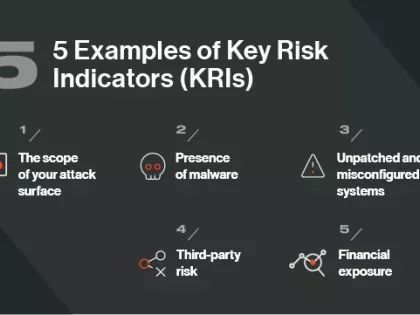7 Keys to Perfecting Your Cyber Risk Management Strategy
Tags:


A cyber risk management strategy is a plan for how you will secure your organization from evolving cyber threats. Your strategy is made up of key elements that work together to create a comprehensive approach to proactively mitigating risks and protecting organizational assets.
Here are the basic steps you should take to develop an effective cyber risk management strategy.
1. Conduct a risk assessment and analysis
Before you can secure your digital ecosystem, you must first understand your cyber risk exposure. What type of threats does your organization face? Which are most critical? What about the security postures of your critical vendors, such as cloud service providers?
To assess where risk is present across your IT infrastructure, conduct an attack surface analysis of your on-premises, cloud, and remote infrastructure (such as subsidiaries, satellite offices, and business units). With this insight, you can better prioritize remediation efforts and allocate resources based on how important at-risk assets are to your organization.
Attack surface monitoring can also reveal hidden assets like rogue devices or shadow IT subscriptions that were previously unknown to the Security Operations Center (SOC).
2. Implement security controls
Implement security controls to safeguard your digital ecosystem. This includes deploying intrusion detection systems, firewalls, and encryption mechanisms to protect against unauthorized access and data breaches.
Establish a regular patching cadence to ensure that all software and systems are up to date with the latest security patches, as part of your vulnerability management efforts. Research conducted by Bitsight has revealed a direct correlation between delays in applying patches and an increased risk of ransomware attacks. Furthermore, the average vulnerability remediation rate across organizations is a mere 5 percent per month.
To ensure that no system or software is left unpatched, continuously and automatically monitor your IT infrastructure for out-of-date assets so that you can move quickly to address vulnerabilities.
3. Practice security performance management
Assessing your own security performance is an essential part of any proactive risk management strategy and can help you quickly understand what’s working in your security program— and improve what’s not.
Security Performance Management draws on cyber analytics, such as security ratings, to take the guesswork out of analyzing performance and setting program goals based on your cyber needs and risk appetite. The higher your rating the better your cybersecurity performance.
You can also benchmark how your cybersecurity performance compares to organizations of a similar size in your industry. With this insight you can make more informed decisions about where to focus your cyber risk management strategy.
Your strategy should also include continuous controls monitoring. By constantly assessing the effectiveness of your security controls you can stay one step ahead of issues that arise over time. This is typically a costly manual effort, but when you apply automation you can quickly inventory your controls, visualize the attack surface your controls are meant to protect, and continuously assess how effective they are.
4. Develop an incident response plan
An incident response plan is key to your cyber risk management strategy. It describes how teams respond to an attack and helps avoid costly delays in discovery and remediation.
Importantly, your plan should not be static. Revisit it often to ensure that emerging risks and new scenarios are accounted for. Every industry is unique, but our blog 4 Things You Should Include In Your Data Breach Response Plan can help you cover the basics.
5. Address third-party risk management
Supply chain attacks are one of the preferred attack vectors for cybercriminals. According to studies, 62 percent of network intrusions originate with a third-party and 73 percent of organizations have experienced at least one significant disruption from a third-party in the last three years.
But how can you be confident that your vendors are doing everything they can to secure themselves and their customer ecosystem from cyberattacks? Traditional vendor risk assessments have their place, but they only provide insight at a point-in-time. They are also costly and challenging to scale across your growing vendor ecosystem.
A more effective way to assess risk in your vendor portfolio is by continuously monitoring, revealing, and remediating supply chain risk—from onboarding through the term of the contract.
Today’s third-party risk management tools go far beyond traditional risk assessments to:
- Shine a light on where security vulnerabilities exist in your vendor’s IT infrastructures.
- Alert you when a new vulnerability is discovered.
- Provide insight into each vendors’ historical security performance.
- Allow you to share findings with your vendors for rapid remediation.
6. Consider compliance and regulatory requirements
Regulators are increasingly scrutinizing the security postures and security performance of organizations across all business sectors. Stay informed about current and future cybersecurity policy and regulations and factor them into your cyber risk management strategy.
The good news is that there are several cybersecurity frameworks that you can follow to ensure compliance and reduce risk.
7. Raise employee awareness
Even with the best security controls and monitoring strategies in place, people can unwittingly expose the organization. In fact, studies show that 85 percent of data breaches are caused by human error.
Whether clicking on a phishing email or connecting to the corporate network from an unprotected public Wi-Fi connection, employees can put your organization at risk.
To mitigate this risk:
- Conduct frequent cybersecurity awareness training and teach employees the techniques that attackers will use to target them.
- Follow-through with frequent testing and simulations.
- Remove the expectation that employees need to respond to emails quickly which can result in employees mistakenly opening phishing emails.
- Give employees an open, judgment-free way to disclose if they think they may have fallen for a scam or exposed the organization to risk.
Ensure an integrated approach to cyber risk management
Developing a cyber risk management strategy is an ongoing process. Take steps to constantly assess and measure progress over time and, if necessary, course correct.
And, because your digital ecosystem is more interconnected and regulated than ever, take care to manage cyber risk holistically.
Bitsight’s integrated solutions address this challenge. With Bitsight you can better assess and quantify your cyber risk, prioritize your cybersecurity investments, and navigate the cyber risk landscape—both internally and across your supply chain—with confidence.


